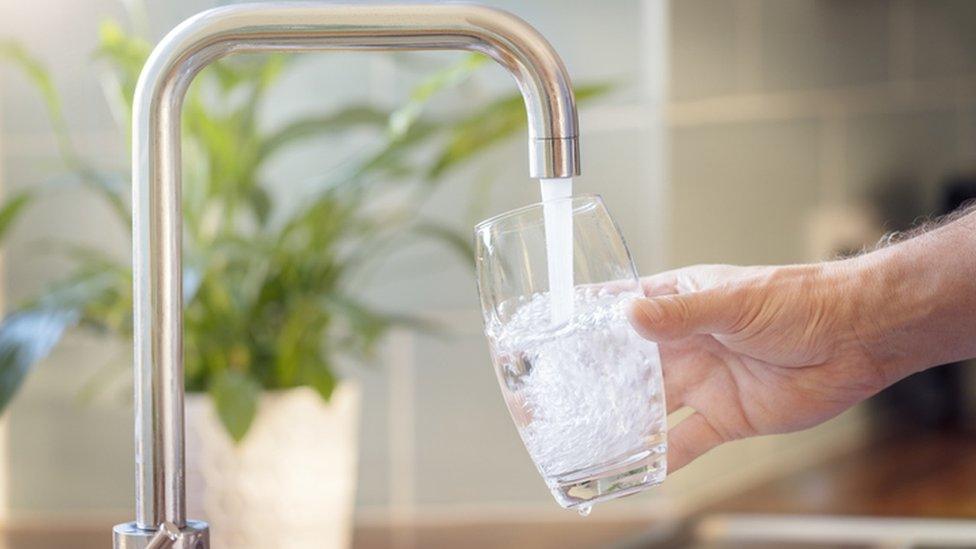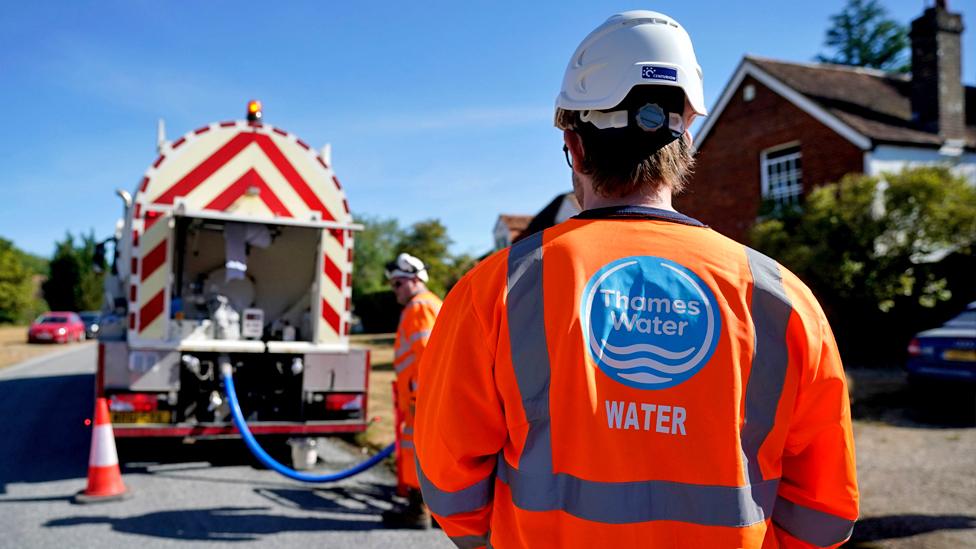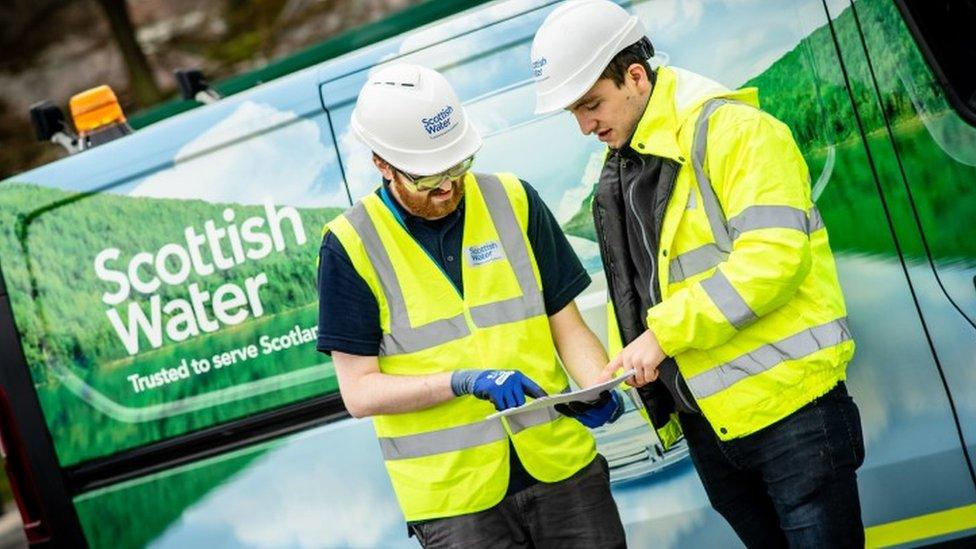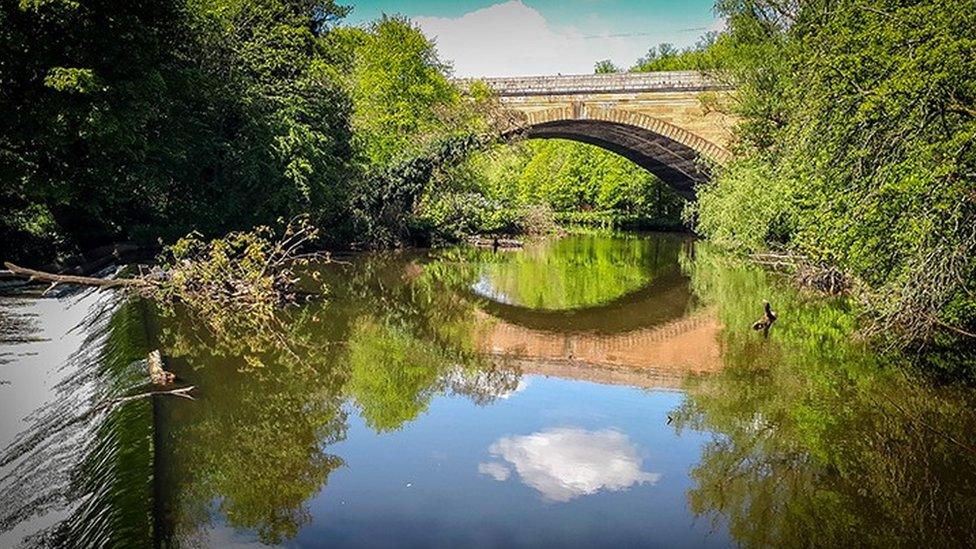Scottish Water: Tuning the pipes
- Published

Huge releases of untreated sewage and Thames Water's financial crisis have heaped criticism on England's private water and sewerage utilities, showing Scottish Water in relatively good light.
But it's not without its challenges. The publicly-owned provider is investing at only 40% of the rate that will be required to tackle the backlog of work from old pipes and the future challenge of climate change.
The departing chief executive has warned that there is a choice: pay more now or pay a lot more later, in failing water supply and infrastructure unable to cope with climate change, as it brings more extremes of flooding and water shortages.
It's not obvious to Scots why we have to pay for water at all, when it is so generously supplied for free from the skies.
It appears even less sensible that it should be a source of profit - and in the case of the English water companies, a torrent of profit.
But it costs a lot to get water to the tap, and to take wastewater away for treatment. Last financial year, the cost was £1.44bn for the Scottish Water group.
Revenue came in at £1.83bn, operating surplus was £210m, and the cost of servicing its debt was £150m. Subtracting administrative costs, there was a pre-tax surplus of £60m.
Those surpluses are ploughed back into the business, and over the years, they have come to nearly £1.9bn, while the company has built up a debt of £4.5bn.
That's not like normal debt, however. It's borrowed on behalf of Scottish Water by the Scottish government, with the backing of the UK government. For that, interest is paid back at lower interest rate than the market rates, but not the principal sum.
If it continues that unusual way, the debt keeps on growing and growing. Unlike Thames Water, it is not owed to international money markets.
Unlike the English utilities, the cost of servicing the debt does not hit a cliff edge when it has to be rolled over, and there is no question of the government having to step in to ensure continuity of supply while shareholder valuation could be wiped out.
Unlike the English water companies, that surplus is not generated by loading up debt and then paid to institutional and international shareholders in artificially inflated dividends. Unlike the privatised utilities, it remains solely owned by government, and therefore publicly accountable.

Thames Water has a debt of more than £14bn, a large share of more than £60bn across the English water sector. Since privatisation more than 30 years ago, these firms have distributed more than £65bn in dividends, but not because they have done a great job at investment.
They have notably failed to avoid vast overflows of untreated waste water into English waterways and onto beaches. That's one reason they have become so controversial.
Thames Water has become vulnerable also to its debt pile, leveraged to 80% of its asset valuation, with interest payments indexed to a particularly high measure of inflation. The abrupt departure of its chief executive last month highlighted that it badly needs a bailout.
If that's not from its existing shareholders, being asked to provide at least £1.5bn, they could lose everything while the UK government steps in with temporary nationalisation.
The risk is of spooking investors more widely, when they are still needed to fund neglected investment in infrastructure.

Scottish Water in numbers (2022-23)

1.51 billion litres of water supply daily
2.62m households
159,219 non-domestic premises
229 water treatment plants
30,516 miles of water pipe
33,691 miles of sewer pipe
1.07 billion litres of waste water treated
1,838 waste water treatment plants

In Scotland, other publicly-owned entities are not looking that impressive - CalMac ferries, Ferguson shipyard, the former BiFab yards, and Prestwick Airport among them. Scottish Water is is one example of a nationalised company that tells a relatively strong story about state control.
There are those who say that should be the model applied also to rail companies, as pandemic disruption and the shortcomings of corporate control have led to train franchises being taken over by government, one by one.
If anything, Scottish Water has a contrasting problem to its private English counterparts, of too much cash. At the end of March, that stood at £487m, down from £657m in March last year.
Scottish Labour's deputy leader Dame Jackie Baillie has been asking if it makes sense to have that much cash in hand when customers are facing a cost of living crisis.
The utility is not without its challenges either. As with other British suppliers, there is a vast bill for the investment needed to replace old infrastructure and build resilience to cope with the challenges of climate change.
By 2041, Scottish Water and its regulators agree that the annual investment bill will have to double from its 2021 level. It's already falling behind on that timetable - investing at only 40% of the rate that will be required.
The increase in bills this year is well below the increase necessary to stick to that timetable, and if such delays are repeated, it could cost customers a lot more in the long term.
That is due to political pressure not to introduce an increase using the formula approved for this six year planning period.
From 2021 to 2027, its main regulator allows Scottish Water to put up bills by Consumer Price Inflation plus 2%. Based on last October's inflation rate, that would have put up bills in April by 13.1%, but the supplier bowed to pressure to limit the increase to 5% this year.
That gap in funding, when it also faces rising costs, is money it won't have for the infrastructure investment needed. But there are those cash balances. Last year, the billpayer was helped with £126m of retained cash.
Untreated sewage
For the past decade or so, Scottish Water has seen its customer satisfaction ratings on the rise, getting into the middle of the pack for British water utilities. Last year, however, the Water Industry Commissioner for Scotland reported a drop in the overall performance measure, but still within the "satisfactory" range.
Leaks remain a problem, particularly if the litres are counted per head of population. Counted per kilometre of pipeline, they look less bad. The company talks of an "economic level of leakage": it's cheaper to let some leaks continue than to fix them all.
The company has been criticised for lower levels of monitoring of untreated overflows when heavy rain is mixed with sewage and discharged without treatment.
That is in comparison with England, where political pressure saw monitoring stepped up, though less success in tackling the root problem of river and beach pollution.
Scottish Water defenders say it has been monitoring waste water in targeted locations where it knows there has been a problem. It has around 3,500 monitors in place, and is responding to pressure by installing 1,000 more over two years.
Scotland is helped by geography - not only more rain and being less densely populated, less intensive agriculture with lower run-off from fields, plus faster run-off from its rivers. Some 87% of bodies of water were rated 'good' or better in the most recent figures, with a target of 92% by 2027.

Only 14% of lakes and rivers assessed in England were found to be in a good ecological condition. Fourteen per cent.
As he departed after more than 10 years as Scottish Water chief executive, Douglas Millican wrote with the annual report just published: "We have no alternative but to increase investment levels and raise customer charges in real terms, if we are to protect services and meet the needs and expectations of our current and future customers.
"At Scottish Water we understand that increasing charges is difficult at any time. But without facing into this, we will simply be passing more of the cost burden onto future generations of customers.
"Although investment levels have increased significantly over the past two years, we are currently investing around only 40% of the necessary long-term replacement rate.
"This will need to rise further to ensure we can keep managing the risks of major service failure and the demands arising from the impacts of climate change."
He concluded: "We must not allow challenges to be deferred because they cannot be afforded. It is ultimately a matter of choice. No matter how difficult this choice may be, the alternative of not having reliable water and waste water services would be far more difficult."
Public control
The reason Scottish Water is under public control is worth recounting, particularly for anyone who can't remember 30 years ago.
The Conservative governments led by Margaret Thatcher and John Major pushed to privatise the water authorities then controlled in Scotland by 12 regional and island councils.
In 1994, pre-devolution, legislation was in the Westminster pipeline which would have seen boards taking over water from councils, their members to be appointed by Westminster government ministers.
Strathclyde Regional Council, based in Glasgow and providing water to around half of Scotland's population, pushed back, showing public opposition with a referendum.
Response to the postal ballot ran at 71%. There were 1,194,667 votes cast against the plan - 97.2% of the vote. The referendum result was not binding, but it had Strathclyde's desired effect. The plans were dead... in the water.
Governments and oppositions have since considered turning the Scottish government asset into a mutual (without shareholders, answerable to its customers).
That might free it up to borrow more in financial markets. That's how water and sewerage are handled in Wales, but the idea hasn't been in political discussion in Scotland for at least a decade.
Instead, water was taken from council responsibilities and folded into three public bodies, covering east, north and west. In 2002, they were folded into Scottish Water, covering the country.
It was subsequently given freedom to compete in the competitive market for non-domestic water supply, in a division known as Business Stream.
Related topics
- Published2 July 2023

- Published29 June 2023

- Published27 June 2023


